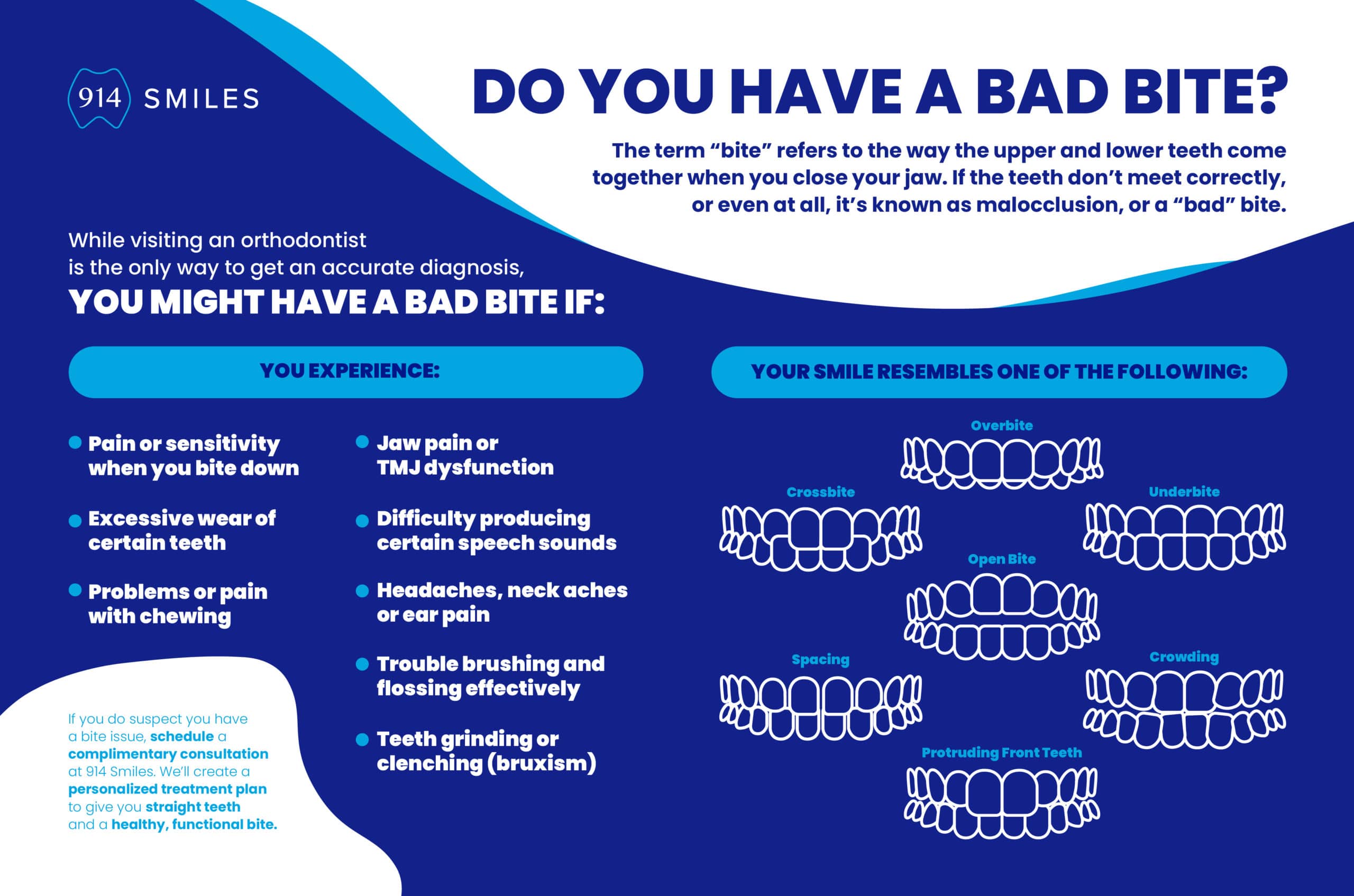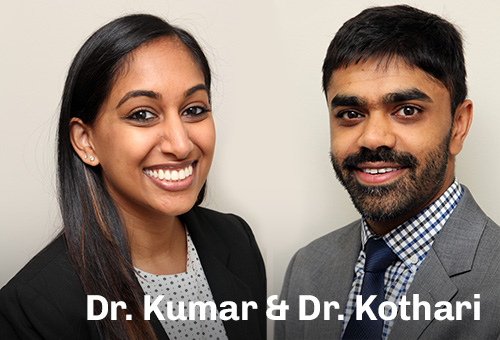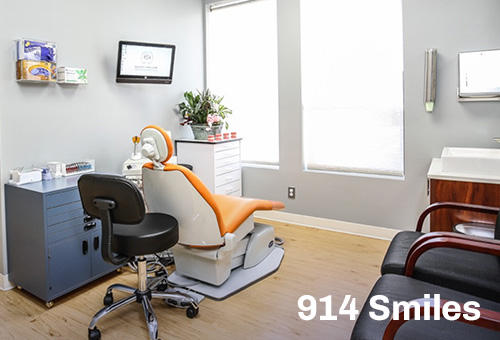
As a certified specialist in orthodontics, Dr. Rishi Kothari is an expert in preventing, diagnosing and treating malocclusion. What is malocclusion? It’s a fancy way of saying an improper bite. The term “bite” refers to the way the upper and lower teeth come together. When you have malocclusion, or a bad bite, the teeth don’t meet correctly or, sometimes, they may not meet at all. In this post, we’ll be covering the most common concerns, how to tell if you have a bad bite, and how it can be treated.
What Does a Normal Bite Look Like?
Before we dive into how to tell if you have a bad bite, first, let’s talk about what a normal bite looks like. When we say normal, we technically mean ideal, because the truth is, most people have some degree of malocclusion, and it’s actually a lot less common to have proper bite alignment and perfectly straight teeth without any intervention.
When the jaws are closed, with an ideal or normal bite, the upper teeth are slightly in front of the lower teeth. There’s gentle contact between the back of the upper front teeth and the front of the lower teeth. About 3/4 of the length of the lower teeth are visible. The rest is covered by the top teeth.
The edges of the top front teeth are parallel to the bottom lip and the midlines (the line between the two front teeth) of the top and bottom teeth line up. The midline of the top teeth also lines up with the middle of the upper lip.
All of the teeth in each arch touch one another without twisting or overlapping or having spaces between them. The points (cusps) of the molars sit in the grooves of the opposite molars.
Having a truly healthy bite also means that the temporomandibular joints (TMJs) are in the correct positions and in harmony with the chewing muscles. You shouldn’t have any pain in the jaw or muscles and you should be able to open and close your mouth and chew with ease.
What are the Common Bite Problems?
Every patient is unique and you could have a combination of problems, however, these are the most common types of bite concerns we see:
- Overbite (Deep Bite) – Overbite refers to the degree that the upper front teeth vertically overlap the lower front teeth. As we mentioned above, a certain degree of overbite is normal and necessary. However, when the overlap is too large, it’s considered an excessive overbite, also called a deep bite. In extreme cases, the bottom teeth may even bite into the roof of the mouth.
- Underbite – If the lower jaw sits in front of the upper jaw, you’re said to have an underbite. Typically, the bottom front teeth will be noticeably in front of the top front teeth and it can cause a “bulldog” appearance.
- Crossbite – A patient has a crossbite when some of the upper teeth sit inside some of the lower teeth when the jaw is closed. An anterior crossbite, or front crossbite, is when the teeth towards the front of the mouth are affected, while a posterior crossbite, or back crossbite, is when the teeth in the back of the mouth are affected. A crossbite can impact a single tooth or groups of teeth.
- Open Bite – An open bite is when the top and bottom teeth don’t touch when the mouth is closed. If you have an anterior open bite, which is the most common type, your front upper and lower teeth won’t meet when your back teeth come together. If you have a posterior open bite, your front teeth will meet but your back teeth won’t touch.
- Protruding or Excessive Overjet – The terms overbite and overjet often get used interchangeably. However, technically, there is a difference. Overbite refers to the vertical overlap, while overjet is the horizontal distance between the top front teeth and bottom front teeth. When the top teeth protrude or flare out and the distance between the upper and lower teeth is too large, you’re said to have an excessive overjet. It’s not uncommon for patients with protruding teeth to also have an excessive overbite, or deep bite.
- Crowding – When there isn’t enough room in the jaw to accommodate all of the teeth, it’s called crowding. With crowding, teeth may overlap, become rotated or look crooked.
- Spacing – The opposite of crowding is spacing. This is where you have spaces or gaps between the teeth.
What Causes Bad Bites?
Malocclusion is most often hereditary and caused by a difference in size between the upper and lower jaw, the shape of the jaw or a discrepancy in your tooth-to-jaw-size relationship. The shape and size of your jaws and teeth are largely determined by genetics. While a specific type of malocclusion could run in your family and be passed down from generation to generation, in some cases, you can get a small jaw from one side of the family and larger teeth from the other, or vice versa.
In addition to genetics, malocclusion can also be caused or exacerbated by:
- Oral habits, such as prolonged thumb sucking or pacifier use
- Myofunctional habits, including mouth breathing and tongue thrust
- Baby teeth falling out too early
- Extra teeth, missing teeth or impacted teeth
- Poor-fitting dental restorations, such as crowns, fillings or bridges
- Orofacial trauma (e.g., jaw misalignment after a jaw fracture)
- Birth defects, such as a cleft palate
How to Tell If You Have a Bad Bite
Sometimes, you can have straight teeth, but still have a bad bite. In other cases, you might have mildly crooked teeth or small gaps between the teeth but an overall healthy bite. The only way to get an accurate diagnosis is to visit an orthodontist like Dr. Kothari for an evaluation.
That said, the following signs could be an indication that you have a bad bite and may need treatment:
You have signs of any of the bite problems we mentioned above, and when the jaw is closed one or more of the following are true:
- Some of the bottom teeth sit in front of some of the top teeth
- You have crowded, crooked or overlapping teeth
- You have spaces or gaps between your teeth
- Your lower jaw sits in front of your upper jaw
- Your top front teeth cover more than half of the length of your bottom teeth
- Your front teeth stick out
- Any of the top or bottom teeth don’t touch
- You have facial asymmetry
- Your teeth don’t feel like they fit together properly.
- The center of the top and bottom front teeth don’t line up.
- You have pain or sensitivity when you bite down.
- You have frequent headaches, neck aches and/or ear pain.
- You clench or grind your teeth, called bruxism. (A misaligned bite can make you more susceptible to teeth grinding.)
- You have trouble chewing properly or you experience pain when chewing.
- You suffer from jaw or TMJ pain and stiffness.
- You have trouble speaking clearly. (The position of the teeth or a lack of room for the tongue to move freely can make it hard to produce certain speech sounds.)
- Some teeth seem to be wearing down more quickly than others.
- You have a tough time properly brushing and flossing.
Why Does a Bad Bite Need to be Treated?
A bad bite should be treated to prevent:
- Uneven or excessive wear of teeth
- Changes in the jaw and facial structure (for example, patients with a crossbite often compensate by shifting the jaw to one side, which can result in irregular jaw growth)
- Undue pressure and stress on the jaw and TMJ, resulting in pain, TMJ dysfunction and headaches
- Cavities and gum disease, because crooked teeth are harder to clean
- Injury to protruding teeth
- Difficulties chewing
- Speech issues
Treating a Misaligned Bite
As for how to fix bite alignment, it will depend on whether the issue is related to the teeth or is skeletal in nature, the severity of the problem and the age of the patient. A bad bite that’s due to jaw growth, such as in the case of an underbite, is often best treated while a patient is still growing. That’s why the American Association of Orthodontists recommends kids have their orthodontic evaluation no later than age 7.
While most kids won’t need treatment that young, if Dr. Kothari spots specific red flags, he can intervene early and use certain appliances to guide jaw growth. This can prevent more serious problems from occurring that would require jaw surgery or extractions and it will make treatment in the teen years easier and faster.
Some problems like mild crowding or spacing can respond to braces or clear aligners alone at any age. Shifting the teeth into their correct places will help the upper and lower jaw come together correctly. However, many times, since braces and aligners straighten the teeth in each arch independently of each other, we’ll need to simultaneously align the bite by using auxiliaries like rubber bands.
When you visit 914 Smiles in Tarrytown for a consultation, we’ll take diagnostic records, if needed, and Dr. Kothari will examine you. He’ll use the records and his findings to determine your diagnosis and create a personalized treatment plan. When creating your treatment plan, he’ll design a smile that complements your unique facial features, while also creating a healthy, functional bite.
Book a Complimentary Consultation With Our Tarrytown Orthodontist
If you have any of the signs of a bad bite or you’re just unhappy with the appearance of your smile, we can help! Schedule a free consultation with Dr. Kothari at 914 Smiles today to get started.



